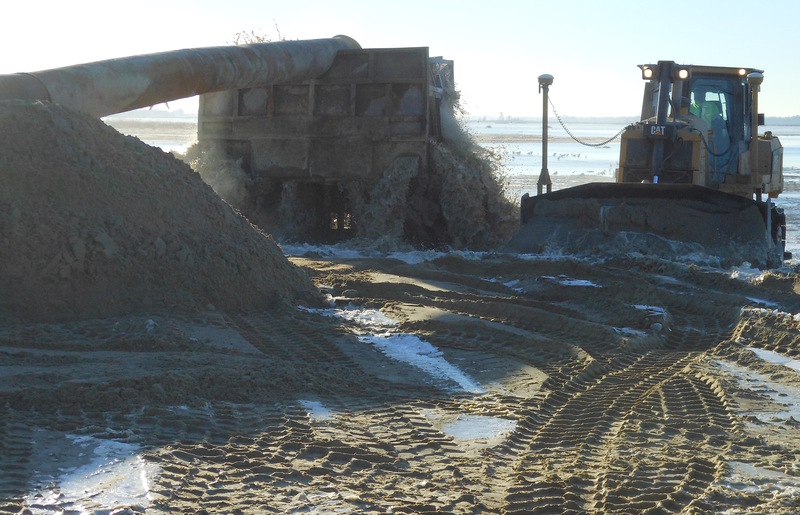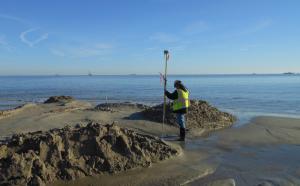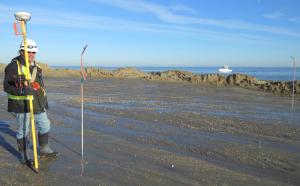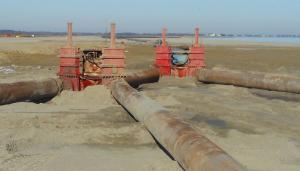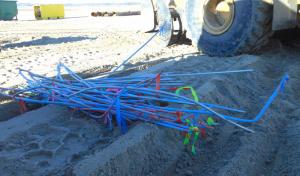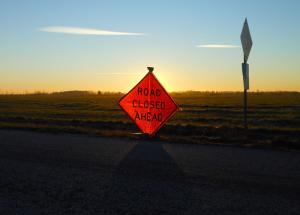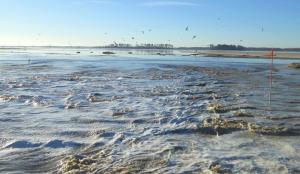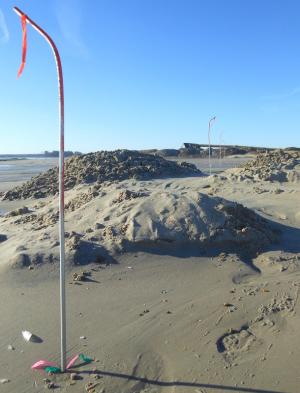Connection made: Prime Hook milestone reached
For the first time since a 2008 Mother’s Day storm breached the dune line between Fowlers Beach and Primehook Beach – and just two months after a $19 million restoration project began – the marsh adjacent to the dune no longer drains into the Delaware Bay at low tide.
Team of Lewes men help shape Prime Hook dune
By Chris Flood
A trio of Cape Henlopen High School graduates working for North Carolina-based surveyor TI Coastal may not be moving the sand associated with the replenishment of the dune in Prime Hook, but they’ll have a direct impact on the dune’s shape.
Abram Lambertson and brothers Jamie and Bo Pratt are the third-party surveyors associated with the $19 million dune restoration.
Lambertson and Jamie are business partners with a third person, Chris Gibson, in TI Coastal Services Inc. It’s the company’s job to monitor the amount and type of sand moved by dredger Norfolk Dredging Co. and to make sure U.S. Fish and Wildlife’s design marks are hit as the sand is being pumped.
The three Lewes men working together happened by chance more than anything else, said Lambertson.
After graduating from college, Lambertson, 36, Jamie, 32, and Bo, 28, all found themselves working for a North Carolina-based branch of Gahagan & Bryant Associates Inc., one of the largest marine-related engineering companies in the United States.
The team worked together for a few years before Lambertson, the Pratt brothers (the sons of Tony Pratt, Delaware Department of Natural Resources administrator of the Shoreline and Waterway Management Section) and Gibson started TI Coastal two-and-a-half years ago. The name pays respect to an island near Wilmington, N.C., called Topsail Island.
During a Jan. 6 tour of the project, on a morning that registered 19 degrees in the company’s well-used Dodge Durango, Lambertson said the size and scope of the Prime Hook project is unusual. In some areas, he said, restoring the dune will require up to 10 feet of fill.
TI Coastal uses GPS technology and multicolored flags to mark the dune’s expected grade on 10-foot aluminum poles. Bulldozers come in behind the surveying team and distribute the pumped sand accordingly.
He said the environment is hard on equipment, especially the bulldozers. The dredge’s pump is running 24 hours a day, he explained, and the bulldozers move the munition cages sitting at the end of the line while the water is running.
Lambertson said he spends about 50 percent of his time working onsite gathering data, while the other 50 percent is spent on the computer turning that data into a readable cross section of the dune. He said the company travels with desktop computers to all the job sites.
“Everything is done on computers,” he said.
Despite the obvious beach-related benefits of marine surveying, Lambertson said there are times when it’s not all fun and games.
“Yeah, it’s fun when it’s 80 degrees and flat water,” he said with a smile. “But yesterday it was well below freezing, and we were walking in the water. But it is pretty fun.”
Bart Wilson, Prime Hook National Wildlife Refuge restoration project manager, announced the progress on a cold but windless Jan. 6 morning following a safety meeting on the newly pumped beach at the end of Fowlers Beach Road in Milford.
Wilson said the water stopped exchanging at low tide shortly after Christmas.
A number of storms since the original 2008 breach, including Hurricane Irene in 2010 and Superstorm Sandy in 2012, widened the breach and created channels more than 10 feet deep in some areas.
Following Sandy, the national wildlife refuge received nearly $40 million in federal funds as part of the Disaster Relief Appropriations Act of 2013.
Other work in Prime Hook includes installing 10,000 feet of sand fencing, planting 20 acres of spartina and 38 acres of other vegetation, and digging 30 miles of channels in the refuge to allow water to flow from one end to the other.
The U.S. Fish and Wildlife Service notes this is the largest coastal marsh restoration on the Atlantic Coast.
Al Rizzo, project leader for the Coastal Delaware National Wildlife Refuge Complex, said he was thrilled to hear Wilson’s report. He estimated the dredger, Norfolk Dredging Co., would completely fill the breach in the next two or three weeks.
“There’s been incredible progress,” he said.
Delaware Department of Natural Resources and Environmental Control Secretary David Small said it was too early to pop any champagne, but the low tide closure was a great first step. The 30-mile system of channels is an equally important component to the project, he said, but there's no question the new dune will be the most visible aspect when its completed.
Small said it had been over a month since he last visited the project site and that it was impressive that what had basically become an open-water inlet was well on its way to becoming a closed marsh again.
It's going to be a long time before it returns to how it was, said Small, but this is a step toward re-creating a sustainable, independent system.
Rizzo said the dune is 500 feet wide at its widest point and averages about 350 feet wide. He said experience has taught designers that a tall dune is not the answer.
“A wide dune is the answer,” he said. “It helps break as much velocity as possible.”
Once the breach is filled, restoration will continue as sand is pumped to widen Primehook Beach.
Wilson said the dune is designed to allow some stormwater washover. He said the idea is that wave energy will decrease as it makes its way over the dune to the soon-to-be-planted dune grass and fencing.
Rizzo said the next phase of the project – fencing and dune grass – was expected to begin this week. He said fencing and dune grass are critical to the future of wildlife habitat once the project is complete.
Chris Flood has been working for the Cape Gazette since early 2014. He currently covers Rehoboth Beach and Henlopen Acres, but has also covered Dewey Beach and the state government. He covers environmental stories, business stories and random stories on subjects he finds interesting, and he also writes a column called Choppin’ Wood that runs every other week. He’s a graduate of the University of Maine and the Landing School of Boat Building & Design.











